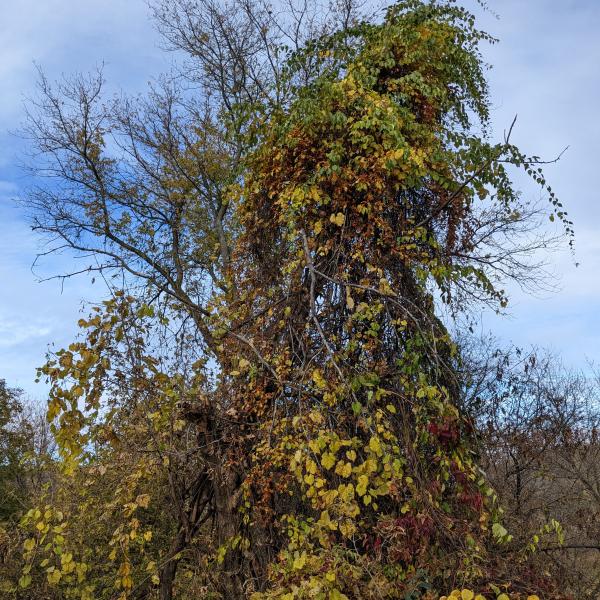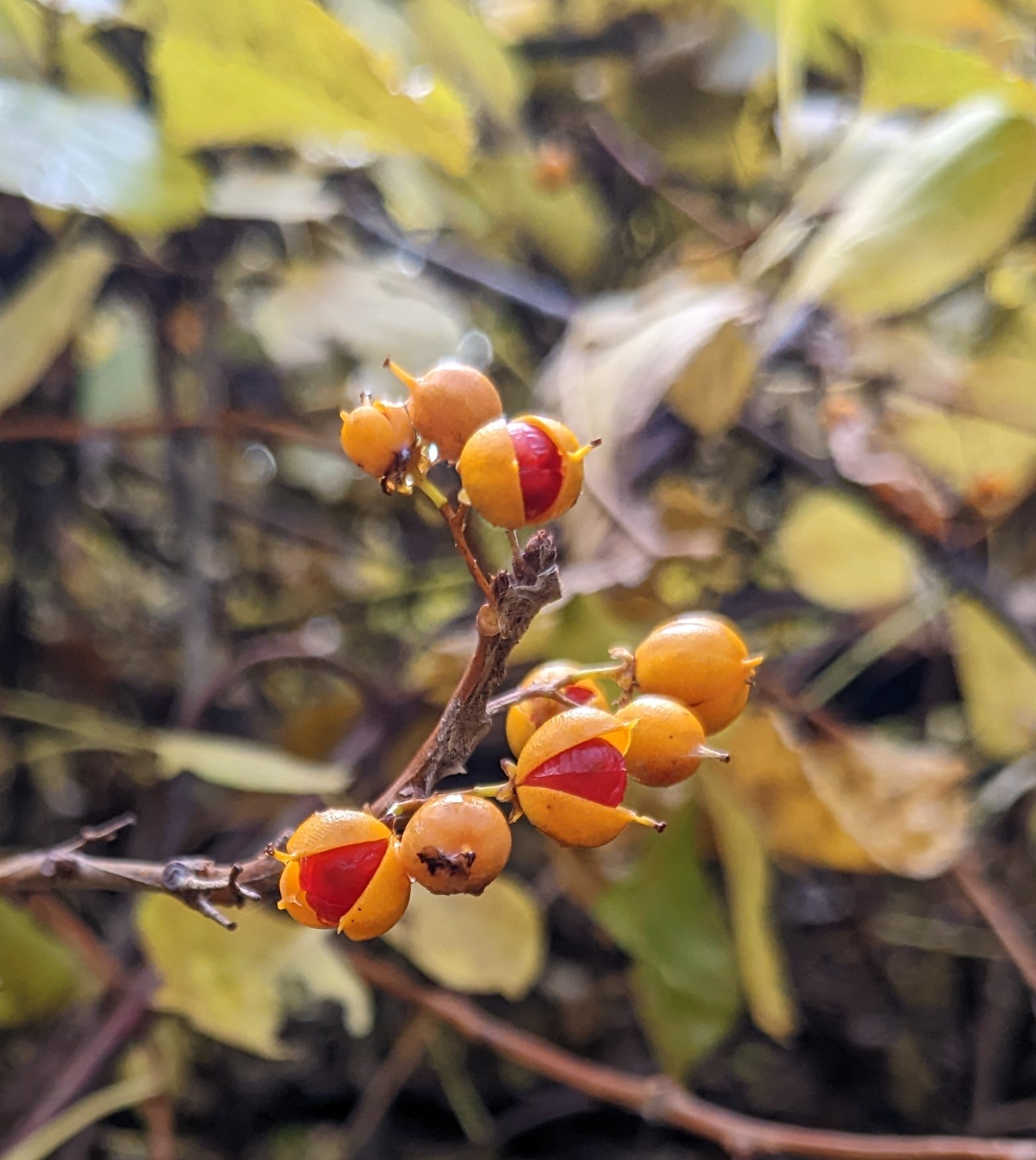
Author: Lina Swislocki, Invasive Plant Assistant Coordinator
October 2022
It’s spooky season, and arguably few places are creepier than the Vermont woods. And, like a jump-scare from a horror movie, sometimes the scariest things are hardest to see.
One eerie feature catching eyes right now is Celastrus orbiculatus, an invasive vine commonly called “bittersweet." Invasive bittersweet originated in Asia, evolving in an ecosystem full of predators and pathogens that provided natural checks and balances on population levels. This vine was introduced to North America as a prized horticultural plant in the late 1800s and has been commonly planted since then – it’s easy to grow and produces very striking fruit. Through most of autumn, the unripe, pea-sized fruit hide behind the still-green foliage; as the leaves yellow, so does the fruit. When the fruit fully ripens, the exterior splits open, revealing crimson arils. These striking colors make invasive bittersweet an attractive temptation for holiday tablescapes and for decorative wreaths, but beware! The threat this plant poses to our yards and forests is anything but beautiful.
 What makes this plant scarier than a clown in a storm drain? There are a few characteristics that make this plant more bitter than sweet. First, the fruit. This plant produces a lot of fruit. The fruit has a high germination rate and (as mentioned) is often spread by people (after all, who can deny the siren call of those colorful berries?). Additionally, animals who eat the fruit excrete the seeds wherever they go, leading to new introductions and further spread. Widespread and vigorous growth are not themselves problematic. However, invasive bittersweet -- which grows primarily in forests, fields, thickets, on forest edges, and in otherwise disturbed areas -- climbs trees to get access to sunlight. Once in the crown of the tree, the vines' weight and expansive branching can smother or strangle the supporting trees, killing them.
What makes this plant scarier than a clown in a storm drain? There are a few characteristics that make this plant more bitter than sweet. First, the fruit. This plant produces a lot of fruit. The fruit has a high germination rate and (as mentioned) is often spread by people (after all, who can deny the siren call of those colorful berries?). Additionally, animals who eat the fruit excrete the seeds wherever they go, leading to new introductions and further spread. Widespread and vigorous growth are not themselves problematic. However, invasive bittersweet -- which grows primarily in forests, fields, thickets, on forest edges, and in otherwise disturbed areas -- climbs trees to get access to sunlight. Once in the crown of the tree, the vines' weight and expansive branching can smother or strangle the supporting trees, killing them.
Second, there is a locally evolved American bittersweet (Celastrus scandens), which developed in Central and Eastern North America. American bittersweet competes against its own local evolutionary constraints, and now also must compete against its invasive cousin. Plus, the way Celastrus species are pollinated has led to hybridization of American and invasive bittersweet species, reducing the already small population of this unusual local plant, and which is now theoretically threatened with extinction.
So, as the days get shorter and the nights get eerie, keep an eye out for invasive bittersweet. The fruits’ seasonal progression will make them easier to spot as autumn moves along. While this invasive plant is commonly found in many places in Vermont, there are still some areas where invasive bittersweet hasn’t yet taken hold, and there are actions that we all can take to spread the word and not the plant.
- Learn how to tell the difference between bittersweet species. The easiest way is by the organization of the flowers and fruit (they are spread along the length of the invasive vine and cluster at the ends of the locally evolved species); find more information here
- When you find invasive bittersweet, please don’t invite it into your home as seasonal decorations, garden plantings, or into your compost. If found, you don’t have to drive a stake through its heart, but maybe consider adding it to our mapping healthy forests iNaturalist project.
- If you choose to manage vines, be careful when trying to dig them up – invasive bittersweet can easily resprout from root fragments left in the ground and (like a zombie) can grow back bigger and stronger. The best strategy, if you’re so inclined, is to cut the berries directly into a thick plastic bag to keep them out of the ecosystem.
- And if you find yourself needing to get rid of invasive bittersweet, its berries, or any other invasive plant, ABSOLUTELY DO NOT throw it in the compost. Instead, contact your solid waste district to find out the appropriate, legal ways to dispose of these environmental tricks, and help make life easier for our locally evolved treats.